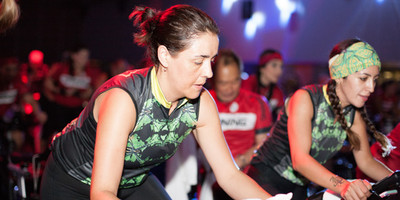By Greg Mantell Since its creation over 20 years ago, the Spinning® program has based its training programs in the latest health and exercise science. With this latest information, it has developed five Energy Zones™ – Recovery, Endurance, Strength, Interval and Race Day – to help instructors and students create their own periodized training programs to every person in class.While indoor cycling is known for the amount of sweat it produces and the number of calories it burns, the Spinning program has devoted a brand
new live workshop to one of the most important aspects of training – recovery. With more and more fitness enthusiasts wanting to train harder and longer to get results immediately, this is the perfect opportunity to look at what a significant role recovery plays in our training.
Remember the Easy Days
Reaching our peak performance typically involves a program of hard days and easy days. Hard days of effort followed by easy days will produce greater results by first pushing our bodies to a breaking point, then taking a step back and allowing them to adapt to the exercise. On the hard days, we push our intensity higher and higher to reach our full potential, but we need the easy days to recover both physically and mentally, as well as avoid the consequences of overtraining.So we should view recovery is a healing process for our bodies. It requires a balance of work and rest to allow our bodies to reach peak performance. This balancing act is best illustrated by Hans Selye’s “General Adaption Syndrome” (1). In it, he identifies two types of stress; a positive stress known as “eustress” and a negative stress called “distress”. Eustress enables us to become stronger by adapting positively to the stressor. Distress, on the other hand, brings negative physiological consequences.So how do we find this perfect balance between work and rest? Because each student is different, the amount of training will vary according to age, background, experience and other factors. Finding that balance requires time and careful observation to discover what works for you and your riders.
What is Recovery Training?
For most people outside of fitness, recovery is commonly viewed as rest. But the best fitness results often involve recovery training at the lower end of our targeted heart rate range (between 50–65% of maximum heart rate) or taking it easier during a particular activity (like a 1–3 out of 10 on a perceived exertion scale). This lighter activity will enable your body and mind to still heal and recover, while also retaining the adaptations and results that we’ve gained from our workouts.While rest or passive recovery can be helpful, studies have shown that physical gains from a workout or stimulus will start to diminish after only 3–7 days (2). That is why active recovery – with the heart rate elevated to no more than 65% of the rider’s maximum heart rate – is key to any training program. And with its low impact and infinitely adjustable intensity, indoor cycling on
Spinner® bikes is ideal for helping students recover appropriately and get the results they want.
How to Reach Your Rides with Recovery
Unfortunately, in today’s fast-paced, get-it-done-yesterday culture, many students approach their fitness thinking they have to train harder and harder to get results quickly. They may want every day to be a Race Day ride, unaware of the physiological damages that overtraining can lead to. As an instructor, making active recovery a regular and enticing part of your riders’ training is necessary.The new Spinning 2-hour workshop provides two profiles and activities that will get you started on developing your own rides. Creating recovery profiles can be tricky when you are limited to mostly flat terrain in a seated position. But in addition to explaining the science behind recovery, the workshop also delivers helpful tips for imparting the importance of recovery to students and cues to keep riders focused and engaged. That’s why the workshop is titled “The Art of Recovery”; it’s more than a science, it’s an art!One subject that the workshop touches on is the mind-body connection. Every second, we receive feedback from our body that will affect our training and activities. Unfortunately, in today’s instant-gratification, get-it-done-now world, we may not receive the messages that our bodies are sending. Now think about your students; with families, jobs and other obligations to attend to, their lives can be filled with distress. But your recovery rides, which provide 30-40 minutes to focus on the mind/body connection and block out all distractions, could provide them with some positive eustress. Suddenly, the opportunity to do a recovery ride sounds much more enticing, and they will have your riders itching to come back to the next class!To learn more about recovery, sign up for
our new workshop today!
References
(1) Rountree, Sage. (2011). The Athlete’s Guide to Recovery. Velo Press.(2) Beaven, C.M., Cook, C.J., and Gill, N.D. (2006). “Effectiveness of post-match recovery strategies in rugby players”. British Journal of Sports Medicine. Found at: http://www.ncbi.nlm.nih.gov/pmc/articles/PMC2491972/

